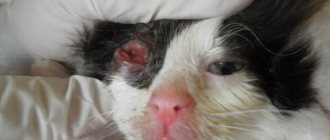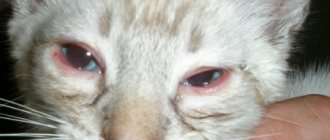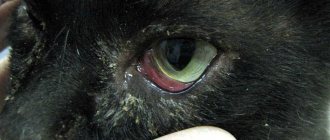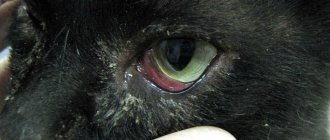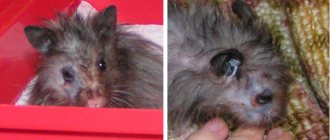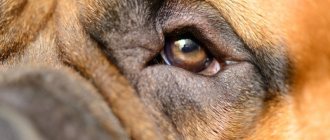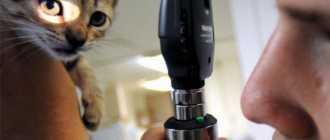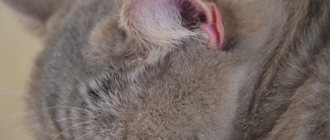Normal eye discharge
In most cases, cats have slightly wet, shiny eyes. The lacrimal glands secrete secretions to moisturize the mucous membranes. This helps clean the outside, prevents drying out and provides some protection from damage. Cats' eyes do not normally run, but they may release a small amount of fluid when they encounter irritants. Bright light, dust, wind or cigarette smoke can act as a provocateur.
Periodic lacrimation is observed in brachycephalics. In cats with flattened faces, the functioning of the glands and the outflow of fluid are disrupted after a long stay in a horizontal position or on the side. Animals with large bulging eyes are more susceptible to infectious inflammation and external factors, since their organs are less protected by skin folds. The risk group includes Persian and Scottish cats, exotics, bobtails, etc. Representatives of these breeds and mestizos, which have inherited specific traits, require careful care and removal of discharge.
Disease prevention
Preventive measures help prevent the development of many pathologies. Cats take care of their own hygiene, but owners need to regularly examine the animal. Pets that are allowed outside need more careful monitoring.
To prevent ophthalmological diseases it is recommended:
- choose only high-quality food for your cat;
- regularly show your pet to the doctor, give it the necessary vaccinations and deworming in a timely manner;
- give the animal the opportunity to be outside and breathe fresh air;
- ensure that the cat does not come into contact with sick or unfamiliar animals;
- trim the animal’s claws in a timely manner so that it does not accidentally injure itself;
- support your pet's immunity in every possible way.
Cats with bulging eyes (eg British, Scottish) require more careful care. They are recommended to wash their eyes with special means, for example Tsiprovet drops, 2 times a day. To do this, drop 2 drops into each eye of the animal, lightly massage its eyelids, and then wipe the skin around the eyes with a cotton pad, removing any leaked liquid.
If brown discharge or other unpleasant symptoms appear in an animal, you should not self-medicate; it is recommended to immediately consult a doctor. Only a specialist can accurately diagnose the disease and prescribe the correct treatment.
The main types of pathological discharge from the eyes
Excessive tearing is not normal, even if the liquid is clear. In case of diseases and injuries in pets, the following main types of pathological discharges can be detected:
- Transparent liquid of normal consistency. A sign of involuntary lacrimation. May occur as a result of injury or in the early stages of disease. Transparent color and liquid consistency indicate the absence of infection. With insufficient hygiene, tears can oxidize and turn into brown crusts, but initially there is no bright shade.
- White mucous discharge. Occurs at the initial stage of inflammation. At this time, it is most often possible to quickly suppress the disease with timely and adequate treatment.
- Greenish or yellow thick discharge. Appear in the last stages of infectious infection. The color indicates the presence of pus. Most often, such discharge is accompanied by general weakness, fever and a state of intoxication. Without help, the animal may lose an eye. Possible death.
- Thick brown or black discharge from your cat's eyes. The hue indicates the presence of red blood cells in the liquid. An increased concentration of red blood cells may be associated with a violation of the anatomical position of the ducts or improper outflow of fluid. Sometimes brown discharge appears in the later stages of infectious diseases if pathogens have penetrated the choroid.
Brown discharge may occur in brachycephalic breeds and breeds with protruding eyes. Conventionally, this sign is sometimes considered normal, but it is advisable to visit a veterinarian for analysis and identification of pathogenic microflora.
DISCHARGE FROM THE EYES IN CATS // Network of Veterinary Clinics BIO-VET
Suppuration: normal or pathological?
Eye discharge does not always appear due to pathological processes developing in the body.
In some cases, pus in a cat accumulates under the eyelids for the following reasons:
- weakened immune system;
- improperly selected diet (lack of nutrients);
- infectious, viral damage;
- unsanitary conditions when keeping animals;
- draft;
- eye injuries;
- allergic reaction to household chemicals, perfumes;
- inflammatory processes in the cornea (keratitis);
- dust in the room where the pet is kept.
On a note! If the discharge is abundant and prolonged, you should not resort to self-medication; the animal must be taken for examination to a veterinary clinic, where the doctor will determine the cause and prescribe adequate treatment.
The owner should pay attention to the color of the discharge. Rare discharge of a grayish tint is normal, and thick discharge of a yellowish or green tint most likely indicates the development of pathological processes in the body
Causes
The appearance of dark discharge and brown crusts around a cat's eyes may be due to a violation of the outflow of fluid through the tear ducts or infectious diseases.
Impaired outflow of tear fluid through the nasolacrimal duct (dacryocystitis)
The development of the disease can occur for several reasons:
- Inflammatory processes. Due to diseases of the eyes and neighboring tissues, swelling occurs. This leads to narrowing of the tear ducts and difficulty in fluid circulation.
- Stenosis of lacrimal openings. Narrowing most often occurs as a result of chronic infectious lesions. Stenosis is accompanied by constant lacrimation.
- Blockage by a foreign body. Small debris can get into the ducts and cause inflammation. Later, infection may occur.
- Mechanical injury. If the canals are damaged, black or brown discharge from the eyes of cats is observed. The color is due to the presence of bloody impurities.
- Neoplasms in the lacrimal glands or adjacent tissues. Tumors cause mechanical narrowing of the ducts. With the simultaneous destruction of tissue, blood appears in the secretions. The color turns red or brown.
Infectious inflammation of various areas of the eye structures
There are several forms of infectious lesions of the organs of vision:
- Blepharitis. Inflammation of eyelash bulbs. The owner may think that the cat has dirt in its eyes. Discharge accumulates in the corners. They may be grayish or brown in color.
- Conjunctivitis. Damage to the mucous membrane, which is accompanied by swelling of the eyelids, redness and the appearance of purulent discharge. In later stages, cats are unable to open their eyes due to crusts.
- Keratitis. Corneal damage. Most often, the disease develops due to mechanical trauma and infection. Pathology is accompanied by the formation of a pathological infiltrate. When deep vessels are affected, the discharge becomes dark in color.
- Iridocyclitis. Inflammation of the choroid. Photophobia is observed in animals. Cats may wash or rub their eyes thoroughly due to pain. First, profuse lacrimation occurs, and later a pathological infiltrate is released.
Symptoms of infectious diseases
Cats are by nature predators and pack animals, so they try not to show their weakness. In order not to miss the onset of the disease and to treat your pet at the initial stage, you should carefully monitor its behavior and condition. A cat's dirty nose is a serious symptom that should not be ignored. And in a small kitten, discharge from the nose and eyes can lead to serious consequences or even a threat to life.
Nasal discharge
If a kitten has pus flowing from its nose, this is a very dangerous symptom. Discharge is a consequence of a malfunction of the mucous membranes. If the irritation is caused by a foreign body entering the nostril, then purulent or bloody discharge will come from one nostril.
Clear discharge from both nostrils accompanied by sneezing is most likely the result of an allergy. Thick, opaque pus coming from a cat's nose is a sign of a respiratory infection or rhinitis. If the purulent discharge is thick, yellow or dark in color with an unpleasant odor, then most likely there is a bacterial infection.
If you notice discharge from your cat's nose, you should contact your veterinarian without wasting any time.
Important! If you find discharge from a cat's nose, you should not think for a long time about what to do, but you need to contact a veterinarian as soon as possible and begin treatment, since with serious inflammation the number of days can go on
Conjunctivitis
Conjunctivitis, an inflammation of the mucous membrane of the eye, is a common disease in cats. Its causes can be very different: inflammation of the eyelids, infectious diseases, injuries or allergies. Inflammation can also occur from irritation of the mucous membrane, for example, from aerosols or cigarette smoke, so you should monitor the cleanliness of the air in the room where pets are kept. Depending on the severity, there are four types of conjunctivitis:
- catarrhal - the most harmless. Transparent drops, similar to tears, are released from the eyes. Sometimes it may be accompanied by an increase in temperature. This is the mildest type of this disease, which with proper treatment goes away easily and quickly, leaving no complications;
- purulent. Thick yellow or green discharge flows from the eyes, sometimes smelling foul. The cause of purulent conjunctivitis is most often inflammation of an infectious nature;
- the danger of phlegmonous conjunctivitis is that pus not only comes out, but also accumulates inside the eye, which can lead to serious complications;
- The most severe type of conjunctivitis is follicular. This is a chronic disease in which the eye follicles begin to rot. Requires complex and lengthy treatment under the constant supervision of a veterinarian.
For your information! If conjunctivitis is not treated on time, the animal may go blind.
Otitis
Purulent otitis in cats is a common and dangerous disease, the causes of its occurrence, as well as the symptoms, can be different:
- mechanical damage. Foreign objects entering a cat's ear can damage delicate tissues, which in turn can lead to infection and inflammation;
- various parasites;
- The main symptom of an allergy is itching. The animal scratches the damaged areas, and dirt getting into the scratches can lead to infection;
- the fungus provokes the development of purulent inflammation;
- Viral pathologies are complications that arise due to improper treatment or its absence.
Important! If a cat does not receive timely treatment, then not only the ear, but also the meninges become inflamed, which can lead to meningitis.
Decreased appetite
Decreased appetite along with nasal discharge may be a sign of a cold in an animal. Snot from a cold is viscous and transparent. In case of serious complications, thick discharge and crusts may appear on the face. If a pet constantly breathes through its mouth, then this also indicates a cold, since its nose is blocked with pus and there is not enough oxygen.
Lethargy
A healthy animal should be active, cheerful and playful. If the cat has become apathetic, uninterested in anything, and has trouble standing on its paws, this is a reason to sound the alarm. Lethargy can be a symptom of diseases such as asthma, bartonellosis, kidney disease, pancreatitis, infectious peritonitis, plague, and many others.
Treatment of the disease
If you have a question about how to treat your cat, you need to contact the clinic. The doctor will examine and interview the animal owner. Fluid may be collected from the tear glands for testing. This allows you to identify the strain of bacteria and select an effective drug. Depending on the causes of the disease, anti-inflammatory drugs and antibiotics can be used. In advanced cases, surgery is performed. Surgery may involve removing the eye, widening the tear ducts, removing a foreign object, etc.
If visiting a veterinarian is not possible, you can administer first aid to improve the condition yourself. It is recommended to use chamomile decoction for rinsing. It is prepared from pharmaceutical raw materials and distilled water. It is important to use clean liquid, otherwise the eye may become infected.
For rinsing you will need a cotton pad. It is recommended not to use gauze or standard cotton wool, as particles may remain on the surface. Rough fabric can damage delicate mucous membranes. A cotton pad is moistened in the liquid and gently wiped from the inner corner to the outer corner. If there are crusts, do not roughly remove them. You should soak the accumulations, then try to carefully remove them.
Both eyes need to be treated. A separate swab is used for each to prevent transmission of infection. It is allowed to use antibacterial solutions for treatment after permission from a veterinarian.
Cat eyes - how to care
The eyes are a very thin and delicate organ that requires proper care and timely treatment for ophthalmological diseases. A healthy animal's eyes are clean, shiny, without discharge or streaks and do not require special care.
The presence of light discharge from the eyes in small quantities is quite normal in cats. Between the eyeball and the mucous membrane of the eyelid there is always a small amount of liquid that provides lubrication, easy sliding of the eyelids over the eyeball and performs a protective function (from falling dust, hairs, etc.). This lubricant is constantly renewed. The “waste” fluid extends beyond the eye into the inner corner, and in the morning you can see a small brown crust in it. By washing their faces, cats easily remove these small secretions with their paws; the owner can remove them with a cotton pad soaked in a special lotion.
You should not rub your eyes, but carefully rub a damp swab over your eyelids, moving from the corner of your eye to your nose, lightly pressing on the bridge of your nose. To top it off, dry the skin around the eyes. Use a separate swab for each eye.
In breeds that have folds of skin near the eyes, such as Persians, it is sometimes necessary to trim the hairs (only with scissors with rounded ends!) parallel to the edge of the eyelid so that they do not get into the eyes and do not leave scratches on the cat's cornea.
If you notice that your pet is squinting, rubbing the eye with its paw, signs such as lacrimation, photophobia, clouding of the cornea, redness of the conjunctiva or third eyelid, enlargement of the eye, the presence of pus in the inner corner of the eye - you should immediately show the animal to a veterinarian ophthalmologist!
Only a qualified specialist can select the necessary medications. There are cases when changed discharge from the eyes is not associated with eye injury, but is a consequence of a viral disease. Trying to solve the problem of cloudy brown tears, you may miss the time to begin serious comprehensive treatment.
If you liked the video, share it with your friends:
You should not rub your eyes, but carefully rub a damp swab over your eyelids, moving from the corner of your eye to your nose, lightly pressing on the bridge of your nose. To top it off, dry the skin around the eyes. Use a separate swab for each eye.
Prevention
Prevention consists of monitoring and caring for your pet. Most breeds do not require intervention, however, in the case of cats with flattened faces, it is necessary to remove the discharge when it appears. The natural secretion, when dried and oxidized, forms a good environment for the growth of bacteria. This increases the risk of developing diseases.
Eye diseases in kittens! Herpes of the eye and calicivirus in cats.
To prevent discharge, it is recommended not to give your cat sweets. Animals metabolize sugar worse than humans. Some of the breakdown products enter the bloodstream and cause a reaction from the immune system. This causes discharge from the eyes, itching and redness of the skin.
All information posted on the site is provided in accordance with the User Agreement and is not a direct instruction to action. We strongly recommend that before using any product, you must obtain a face-to-face consultation at an accredited veterinary clinic.
Pet treatment
If your cat's nose begins to turn black, you should not self-medicate or waste time. Without special education, it is impossible to establish the exact reason why the nose turned black or discharge began. And not only the pet’s health, but also its life often depends on a timely visit to the veterinarian. It is useful to always have in your phone the contacts of a good veterinary clinic that is open 24 hours a day. One day this could save a pet's life.
Only a veterinarian can correctly diagnose and prescribe treatment for a cat.
Important! It should be remembered that water is much more important than food. The animal will live no more than two days without water, so you need to carefully monitor the pet and, if necessary, forcefully water it from a syringe, after immobilizing its paws
Disorders with excessive tearing
As for pathologies that lead to excessive tear production, these include those that cause severe irritation of the ocular surface.
First of all, it is conjunctivitis. It can be viral, bacterial, fungal, and also develops as an allergic reaction. With this disease, the mucous membrane of the eye becomes inflamed, severe redness, itching and profuse lacrimation are observed.
Another reason is blepharitis or inflammation of the eyelids, which occurs due to a bacterial infection or mechanical damage against a background of reduced immunity. It is characterized by inflammation of the eyelids and accumulation of discharge in the corners of the eyes. When ulcers appear on the inner surface of the eyelid, the discharge becomes brown or reddish.
Brown discharge from the eyes of cats can appear due to inflammation of the cornea (keratitis), inflammation of the iris and ciliary body (iridocyclitis), and glaucoma.
Irritation of the eye, and, as a result, excessive tearing occurs with such anomalies as: inversion or eversion of the eyelids, abnormal growth of eyelashes towards the eyeball, an additional row of eyelashes. In these cases, permanent injury to the cornea of the eye occurs with eyelashes. Inflammation often develops and becomes chronic.
Why do my cat's eyes run?: reasons
There is no need to panic and think that your pet is very ill. Below we have compiled a list of the most common reasons why cats may have discharge from their eyes.
- Reasons why a cat's eyes are running:
- Allergies come first. An allergic reaction in cats can be to anything, even to the new food you bought for your pet. Or your pet cannot tolerate spring blooms. Also if the cat is on natural food. However, allergies are easy to identify. The kitten usually sneezes a lot. Among other things, if a cat is drooling, allergies are the most likely cause, because during an attack, swelling of the mucous membrane usually occurs.
- Viral infection. A cat's eyes are a delicate and defenseless organ that is very sensitive to various influences. As a result of exposure to the virus, various tumors can appear around the eyes, which can sometimes impair vision.
- Microdamage. If a visual inspection does not reveal any damage, then it is quite possible that the cat received a microtrauma, which is very worrying for him.
- Foreign body. If a foreign body gets into a cat’s eye, this may well cause lacrimation, pain and the pet’s desire to get rid of it as soon as possible. In this case, only a veterinarian can help.
- Poor nutrition - in this case, tears may be a reaction to allergies or excessive sweetness. Never treat your fluffy with sweets, cakes, or sweet yogurt. All this is quite dangerous for the animal.
- A sour eye in a cat can also be a consequence of the fact that some kind of infection is raging in the pet’s body, which means that the owner requires maximum attention to it. Among other things, intestinal parasites can also be an indirect cause of inflammation and excessive tearing.
- Colds. Natural predisposition. For example, Sphynx cats most often suffer from lacrimation. In this case, the owner just needs to carefully wipe his eyes with a cotton pad dipped in lukewarm water.
- Allergic reactions to household chemicals, cosmetics and other substances. This reason requires immediate seeking veterinary help. The doctor will not only eliminate the cause of the itching, rinse the eye, but also prescribe treatment so that the inflammation does not go too far.
This is not a complete list of reasons why a cat’s eyes are running, there can be a great many of them.

